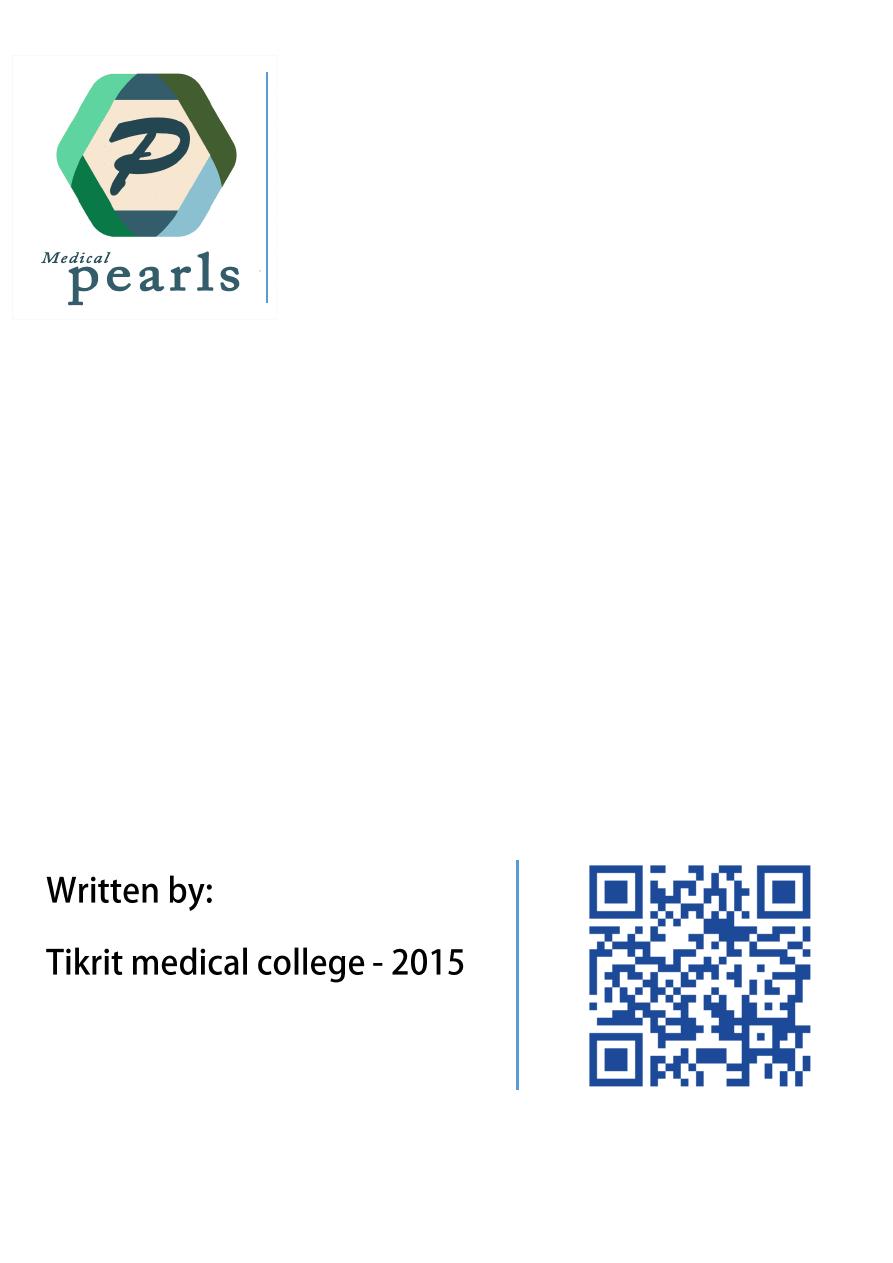
1
Omar saad
http://www.muhadharaty.com/pearls_in_epilepsy
http://www.facebook.com/medicalpearl
Medicine
Neurology series
{Pearls in epilepsy}

2
General:
Epilepsy is the tendency to have recurrent seizures.
Epilepsy occur in 0.5-1% of the population.
Prevalence of epilepsy is 5 times higher in developing countries than others are.
40 fold increased risk of sudden death in epilepsy!
Epilepsy is a symptom of the brain disease not a disease itself.
A single seizure is an indication for investigation.
Any brain can develop seizure.
The recurrent rate after the first seizure is about 70% within the first year mostly within
a month or two month from the first attack.
Seizure could be motor, sensory or mixed.
Febrile convulsion (motor seizure) is different from epilepsy can be recurrent but only
when there is fever and occurs mostly in children.
Clinical presentations:
Partial seizure signifies the presence of focal cerebral pathology, except few cases of
benign outcome in childhood.
Epilepsy presenting in adult life is usually secondary generalized, even if there is no
clear history of a partial seizure before the onset of a major attack (an Aura).
Epilepsy after the age of 60 is usually due to CVA.
Simple Vs. complex partial seizure = conscious Vs. Unconscious(Hallucinations of smell,
taste)
Absence seizure characterized by transient loss of consciousness but the patient
remain standing or sitting.
More than one type of seizure may occur in the same patient at different times.
severely bitten bleeding tongue is pathognomonic of generalized seizure
Post-ictal confusion and amnesia is useful in differentiating seizure from syncope, in
case there is no tonic or clonic phase neither the patient biten his tongue or develop
central cyanosis.
Psychogenic or pseudo-seizure may be accompanied by dramatic flailing of the limbs
and arching of the back, and usually not followed by same degree of post-ictal
confusion.
Pos-ictal phase of seizure usually characterized by :
1-Confusion
2-Amnesia
3-Headache
4-Tendency to sleep

3
Complex partial seizure arising from the anterior parts of the frontal lobe may produce
bizzare behavior patterns including limb posturing, sleep walking, or even frenetic with
incoherent screaming.
Absence seizure (petit mal) is not associated with post-ictal confusion and does not
cause loss of posture.
Atonic seizure, brief loss of muscle tone, heavy fall with or without loss of
consciousness, occur only in patients with epilepsy.
Jacksonian seizure: begin in one part of the body and spread to other parts (partial
motor seizure).
Todd`s palsy: paresis of the limb involved in seizure lasting for several hours after the
seizure ceases.
Versive seizure: frontal epileptic focus involving frontal eye field, causing forced
deviation of the eyes and sometimes turning of the head to the opposite side, usually
develop into GTC seizure.
Partial visual seizure:
1- Occipital focus; balls of light or patterns of colors.
2- Temporal focus; faces or scene.
Always doctors confuse between complex partial seizure and absence seizure because
in both cases pt. present dazed and confused!
Psychogenic or non-epileptic attacks, characterized by asymmetrical non-stereotype
movement without harming self, no cyanosis, no tongue bit, continuous screaming
throughout attack, tongue bit without bleeding, no post-ictal headache, confusion,
amnesia, sleeping, with normal EEG and normal plantar reflex(all the mentioned
features may present in true epileptic attack).
Psychogenic seizure or pseudo-seizure, 3 times more common in women associated
with Hx. of sexual abuse. Moreover, it is very difficult to treat and require
psychotherapy rather than drugs.
Pearls in Treatment:
You cannot use more than two drugs at one time in epilepsy.
First line drugs for partial/secondary GTC, Primary GTC, Absence and myoclonic are
carbamazepine, sodium valproate, and ethosuximide and sodium valproate
respectively.
Second line drugs for absence and myoclonic epilepsy are sodium valproate and
clonazepam respectively.
Childhood onset epilepsy (classical absence seizure) carry the best prognosis for
successful drug withdrawal.
Drug withdrawal after complete control of seizure 2-4 years may be considered.
Recurrence rate of seizure after drug withdrawal is 40%.

4
Withdrawal should be slowly over 6-12 months.
Women on Oral Contraceptive pills (OCP), best anticonvulsant is sodium valproate (or
lamotrigine), while others as carbamazepine, phenytoin, barbiturates, topiramate
induce hepatic enzymes and increase the metabolism of estrogen thus causes OCP
failure.
Almost all anticonvulsant causes fetal abnormalities (cleft lip, spina bifida, cardiac
defects) EXCEPT GABAPENTINE
Sodium valproate associated with menstrual irregularities and POCS
Liver-enzyme inducing anticonvulsant causes osteoporosis.
3rd trimester is the most common time for seizure in women with epilepsy due to
decrease plasma levels of drugs at that time.
In epileptic women wants to get pregnant, start folic acid 5 mg two months prior to
conception, to abolish the side effects of drugs on the child e.g. spina bifida.
Anticonvulsant increases hemorrhagic diseases of the newborn, so give 20mg of
vitamin K daily in the last month of pregnancy, and 1mg I.M to the infant at birth.
Generalize seizure are more likely controlled than partial seizures.
Pearls on status epilepticus:
Status epilepticus: A seizure or series of seizures lasting 30 minutes without the
patient regaining awareness between attacks.
Status epilepticus is never the presenting feature of idiopathic epilepsy but may be
due to:
1-abrupt drug withdrawal.
2-Major structural lesion
3-Acute metabolic disturbance
Status tend to be more common with frontal epileptic foci.
Psychogenic or non-epilepticus attacks commonly masquerade as status epilepticus!
So confirm by EEG.
Source:
Nici R. Colledge, Brian R. Walker, Stuart H. Ralston. Davidson’s principles and practice of
medicine.21
st
edition; 2010.
